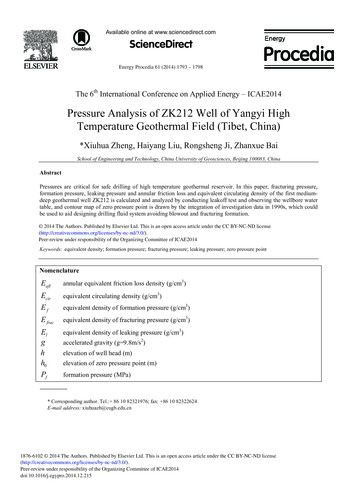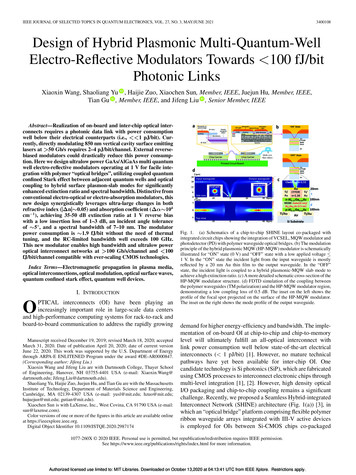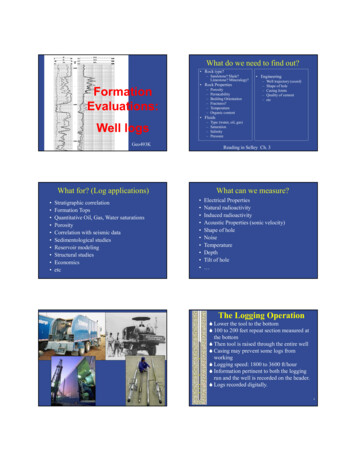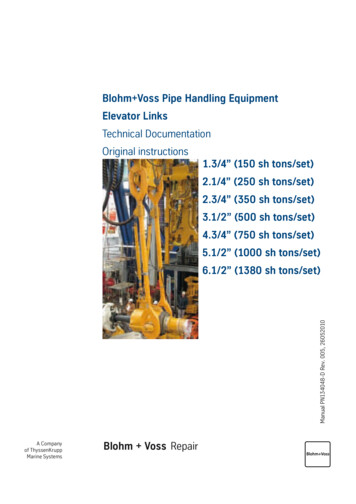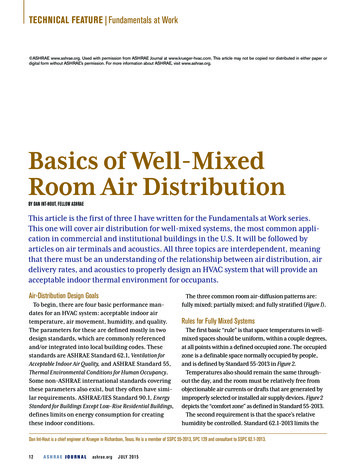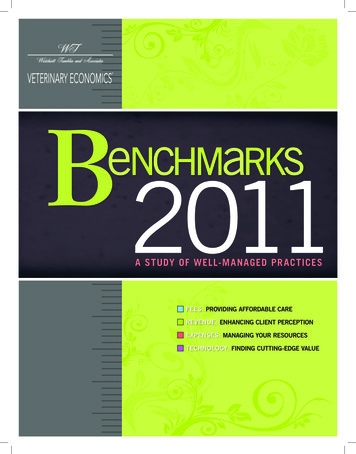
Transcription
B 2011A STUDY OF WELL-MANAGED PR ACTICESFEES: PROVIDING AFFORDABLE CAREREVENUE: ENHANCING CLIENT PERCEPTIONEXPENSES: MANAGING YOUR RESOURCESTECHNOLOGY: FINDING CUTTING-EDGE VALUE
BENCHMARKS 2011ContentsIntroduction PAGE3PAGE6Through a research partnership between Wutchiett Tumblin and Associates andVeterinary Economics, we bring you Benchmarks 2011: A Study of Well-ManagedPractices, a must-have tool to help you improve your business. This introductionoffers the goals and history of the study and explains what the results can dofor you and your practice.Executive summary The new normal requires businesses to be more creative and innovative thanever. You can no longer afford to say, “We’re good enough,” “We’re average andthat’s OK,” “That’s just the way it is,” or “It’s the economy.” It’s time to jumpstart your practice and apply some new ideas—even if some of those new ideasmake you a bit uncomfortable. After all, discomfort is often a sign of learningand transformation.CHAPTER 1Fees PAGE11PAGE31If given the choice between a cheaper option and a more expensive option andgiven little to no information to differentiate between two veterinary practices,many people will pick the less-expensive option. The lesson, though, is not toalways be the cheapest option. The lesson is to differentiate yourself.TOOLSConducting a community survey . . . . . . . . . . . . . . . . . . 24Pet insurance: The insider perspective . . . . . . . . . . . . . 29Compare your value-based fees . . . . . . . . . . . . . . . . . . 30CHAPTER 2Revenue Owners of Well-Managed Practices don’t have a magic elixir to stop decliningclient visits or end the recession, but they do know they must take every opportunity to preserve and protect their client relationships. The stronger the relationship, the more likely it is that clients will remain with your practice.TOOLSCritical components of veterinary practice revenue . . . . 36Worksheet: Boost your revenue . . . . . . . . . . . . . . . . . . . 37Checklist: Opportunities to enhance value . . . . . . . . . . 39
BENCHMARKS 2011: A Study of Well-Managed PracticesContents2CHAPTER 3Expenses PAGE40PAGE58Cash. Inventory. Equipment. Expenses. Time. How does a busy practice manageall these and remain profitable? Well-Managed Practices have shared how theyprevent fraud and manage their expenses to keep a healthy bottom line.TOOLSChecklist: Simple steps to prevent fraud . . . . . . . . . . . . 50Tips to prevent fraud using your management software 51Cool ideas to control hot inventory . . . . . . . . . . . . . . . . 53The pluses of a home delivery pharmacy . . . . . . . . . . . 54Prescription refill opportunity calculator . . . . . . . . . . . . 55Are your employees ‘stealing’ time? . . . . . . . . . . . . . . . 56CHAPTER 4Technology Moving your practice information online doesn’t mean you’ll have to sacrificeyour practice’s personal touch. The Internet is simply another way to engageyour clients and potential clients using a new medium. You want to make yourpractice as personal and convenient as possible to keep clients coming back, anda website, social media, and more can do just that.TOOLSThe social veterinarian . . . . . . . . . . . . . . . . . . . . . . . . . 66Timeline for implementing online practice tools . . . . . . 69How to make your website sing your practice’s praises . 70Social media marketing . . . . . . . . . . . . . . . . . . . . . . . . . 717 tips to enhance client communication . . . . . . . . . . . . 73Electronic medical records: In the trenches . . . . . . . . . 75
BENCHMARKS 2011IntroductionThis study is different from your usualcollection of data. First of all, this is aBenchmarks study, which means it hasnothing to do with across-the-board industryaverages. Rather, this study takes a look at thebest of the best: Well-Managed Practices. Theidea is that by exploring how these top-notchperformers set fees, bring in revenue, manageexpenses, and generate profits, you’ll be ableto emulate their success.For more than two decades, veterinaryfinancial consulting firm Wutchiett Tumblinand Associates in Columbus, Ohio, hasstudied these strong practices to learn howthey enhance clients’ perception of value,grow in a tough economy, know when tospend and when to cut back, and utilizetechnology. And now, through a partnershipwith Veterinary Economics magazine, webring you Benchmarks 2011: A Study ofWell-Managed practices. This book is amust-have tool as you build a strong practice—even in shaky times.To compile the data on the following pages,we asked 100 companion animal practiceowners to complete a detailed electronic questionnaire. Led by Denise Tumblin, CPA, ownerand president of Wutchiett Tumblin and Associates, a team of management consultantsscrutinized each practice’s financial data andstrategies in the areas of fees, earnings,expenses, and technology.The makings of aWell-Managed PracticeSo just what constitutes a Well-Managed Practice? The 100 small-animal practices surveyedhad to meet the following criteria:Patients come first. Practice owners never losesight of the fact that they went into practice topromote patients’ health and well-being.The practice runs efficiently. These practices earnenough profit to have a healthy amount of revenueleft over after they pay all of their variable andfixed costs, nondoctor staff compensation, andrent expenses. Specifically, a Well-Managed Practice averages a profit-to-gross-revenue ratio of 34percent to 42 percent. This means that a practiceearning 2 million in revenue would have at least 680,000 left to pay owners and associates andreinvest in the practice.Practice owners enjoy practicing veterinary medicine. A love of the profession comes throughin practice owners’ attitudes toward their teammembers and clients. And when clients and teammembers are happy, they stay with the practice.Practice owners foster a culture of respect. Teammembers are people first and foremost, andWell-Managed Practice owners know they mustappreciate doctors and team members for whothey are more than the roles they play. Theowners value all their team members and striveto help them achieve their potential.The numbers behind aWell-Managed PracticeOn the following page are charts and statisticsto give you a behind-the-scenes look at the financial situation at Well-Managed Practices. Considerwhether these benchmarks are true of your practice, and then read on to find more details on fees,revenue, expenses, and team management—plustools to help you get where you want to be.
BENCHMARKS 2011: A Study of Well-Managed PracticesIntroductionWho participated in Benchmarks 2011?3%5%6%7%9%13%32%3%Estimated average total compensation per owner for the year 201022% 221,700(Includes veterinary salary, management fee, return on investment, and benefits)Total practice revenue by percentile25th percentile50th percentile75th percentile 1,186,945 1,844,025 2,574,940Range: 562,000 to 7,412,489Total revenue per doctor* (Medical hours only)Less than 450,000 450,001 to 500,000 500,001 to 550,000 550,001 to 600,000 600,001 to 650,000 650,001 to 700,000More than 700,000*CALCULATED BASED ON FULL-TIME EQUIVALENT OF 40 HOURS PER WEEK14%7%14%17%21%6%21%4
BENCHMARKS 2011: A Study of Well-Managed PracticesIntroductionNumber of doctors at the practice*OwnersAssociatesOwners and 62.13.65Numbers roundedNumber of doctors at the practice*9%7% 214%2.01 to 33.01 to 416%30%4.01 to 524%5.01 to 6More than 6Staff-to-doctor ratio* (Doctor medical hours only)ManagerReceptionist/client care coordinatorCredentialed technician/patient care coordinatorVeterinary assistantWard attendantTotal0.41.21.21.10.44.3Owners:Rate the amount of practice revenue and expense information you share with your staff and associateson a scale of 1 to 512345No informationLittle informationSome informationConsiderable informationMost Information1%17%48%7%27%Associates and staff:Rate the amount of practice revenue and expense information your owner shares with you on a scale of 1 to 5ASSOCIATESMANAGERSSTAFF1 No information6%0%10%2 Little information23%17%18%3 Some information33%17%34%4 Considerable information10%33%18%5 Most Information27%33%20%Numbers roundedAssociates and staff:Rate your knowledge about the business and financial side of veterinary medicine on a scale of 1 to 512345No informationLittle informationSome informationConsiderable informationMost %22%33%39%3%20%44%10%23%*CALCULATED BASED ON FULL-TIME EQUIVALENT OF 40 HOURS PER WEEK
BENCHMARKS 2011Executive summaryIt’s safe to say that the past 18 to 24 monthshave rocked our world. Revenue and profitis down for some practices, and thosewho’ve been lucky enough to see growth knowit’s certainly not what they’ve been accustomedto in the past. Owners and managers have hadto develop strategies to address this “newnormal” way of doing business.On the plus side, the new normal requiresbusinesses to be more creative and innovativethan ever. You can no longer afford to say,“We’re good enough,” “We’re average andthat’s OK,” “That’s just the way it is,” or “It’sthe economy.” It’s time to jumpstart yourpractice and apply some new ideas—even ifsome of those new ideas make you a bituncomfortable. After all, discomfort is often asign of learning and transformation.So stretch beyond your comfort zone andembrace the creative and innovative strategiesfrom some of the best practices across thecountry found in each chapter in Benchmarks2011: A Study of Well-Managed Practices byWutchiett Tumblin and Associates and Veterinary Economics. You’ll find a variety ofFTE doctors per practiceFewer than 22.01 to 33.01 to 44.01 to 55.01 to 6More than 6management tools designed to help you getahead, along with opinions from the associatedoctors, managers, and staff in key areas.Remember that success isn’t determined byyour results but rather by your momentum.Momentum is fueled by how you feel. And howyou feel is determined by the consistent dailyapplication of the best you have in you each day.Benchmarks 2011participant profile trendsOwner compensation is down about 5 percentthis year. The average total compensation perowner for the year 2010, including veterinarysalary, management fee, return on investment,and benefits, is 221,700.The past four years also show a change inthe number of full-time equivalent doctorsand staff and higher production per full-timeequivalent (FTE) doctor, indicating that practices are striving for more productivity andefficiency with fewer people:The average total number of FTE doctorsper practice was 3.6 in this year’s study, downfrom 4.0 in Benchmarks 23%26%14%9%14%14%30%24%16%9%7%Numbers roundedStaff members per entialed techniciansurveyVeterinary assistantWard 21.10.44.3* ALL BENCHMARKS STUDIES REPORT DATA FROM THE YEAR PRIOR. FOR EXAMPLE, THE 2008 STUDYREFLECTS 2007 INFORMATION, THE 2009 STUDY REFLECTS 2008 INFORMATION, AND SO ON.
BENCHMARKS 2011: A Study of Well-Managed PracticesRevenue per doctor*Medical revenueOther revenueTotal revenueMedical revenue per doctor hourAverage doctor transaction (ADT)BENCHMARKS2008 553,000 69,000 622,000 288 152BENCHMARKS2009 535,000 71,000 606,000 279 157Executive SummaryBENCHMARKS2010 535,000 62,000 597,000 279 1677BENCHMARKS2011 547,000 65,000 612,000 285 167CHAPTER 1Fees: Providing affordable careWith the recession still rearing its ugly head,fee increases for veterinary services continue tobe a sensitive issue. Well-Managed Practiceseducate their clients regarding the benefits ofhigh-quality care and the options for payment,including pet insurance and payment planproviders like CareCredit (the most commonlyused) and Chase Health Advance.Ninety percent of study participants reportthat 10 percent or less of their clients have petinsurance. One-third of the participants statedthat in the past two years the number of theirclients with pet insurance has grown 1 percentto 5 percent, and another 16 percent reportgrowth of 6 percent to 10 percent in clients’usage of pet insurance.Here’s a sampling of fees with a comparison to Benchmarks 2009:Physical examAvian examComprehensive examMedical progress examHospitalized patient examBlood pressure evaluationCorneal fluorescein stainEar swab and stainRadiograph, film, 2 views (8x10)Radiograph, film, additional view (8x10)Radiograph, digital, 2 views (8x10)Radiograph, digital, additional view (8x10)Blood glucose test (single)BUNCBCCBC with serum chemistry profileFecal centrifugationFeline leukemia, FIV, heartworm testCanine heartworm, borreliosis, ehrlichiosis testSurgeon’s fee per minute, soft tissueSurgeon’s fee per minute, orthopedicSurgical assistant per minuteBENCHMARKS2009BENCHMARKS2011 46 50 59 35 35 33 24 27 123 46 136 50 23 28 48 111 25 59 45 6 7 0.90 48 54 62 39 36 35 25 30 134 52 142 52 25 29 52 122 27 58 42 6.38 7.50 1.00Take a look at page 11 for complete fee results. Want to gauge your own fees against WellManaged Practice targets? Flip to page 12 to see how your practice stacks up.*CALCULATED BASED ON FULL-TIME EQUIVALENT OF 40 HOURS PER WEEK; MEDICAL HOURS ONLY.
BENCHMARKS 2011: A Study of Well-Managed PracticesExecutive Summary8CHAPTER 2Revenue: Enhancing client perceptionA big concern in veterinary practices right nowis the declining number of client visits. From2008 to 2009, Well-Managed Practices sawabout an 8 percent decline in the number ofdoctor-provided invoices. Non-doctorprovided invoices increased by the same 8percent. Perhaps this change can simply beInvoices per buted to how practices credit invoicesrelated to prescription refills—we have no wayof knowing for sure.From 2009 to 2010, doctor-providedinvoices rose slightly. The invoice numbers perFTE doctor from the most recent Benchmarksstudies 5,5833,0212,5075,528We also observed a 15 percent to 18 percent decline in the number of active and new clients,and a 14 percent to 20 percent decline in the number of active and new patients.Clients and patients per doctorActive clientsNew clientsActive patientsNew patientsTo combat the decline in client and patientnumbers, Well-Managed Practices add valueto the client experience whenever they can.Chanda Holschbach, hospital administratorand owner of Packerland Veterinary Center inGreen Bay, Wis., says, “Because of the lengthof employment of our staff, they’re able torecognize and greet clients and pets by namewhen they enter the building. It puts apersonal touch on clients’ experience andkeeps them from feeling like just a number.”Well-Managed Practices add services tobetter serve patients and attract and keepclients. In the past two 2009BENCHMARKS20101,185Did 45 percent of Well-Managed Practicesadded digital radiography22 percent of practices added therapeuticlaser treatments13 percent added nutrition counseling10 percent added ultrasound services.Find more on page 34. Take a look at therecommendations for improving your revenue,also starting on page 34, and remember whatDrs. Peter Farrell and Michael Rach, ownersof Burnt Hills Veterinary Hospital in BurntHills, N.Y., keep top of mind: “Clients wantto know how much you care, not howmuch you know.”»»»»»»
BENCHMARKS 2011: A Study of Well-Managed PracticesExecutive Summary9CHAPTER 3Expenses: Managing your resourcesYou know the mantra. There are two ways tomaximize the bottom line—increase revenueor decrease expenses. If you’re like many veterinary practices across the country, revenuegrowth, while desirable, may have been a chal-Expense typeVariableFixedStaffFacilityReinvestmentlenge in the past two years. Implement strategies to boost revenue from Chapter 2, thenturn to your expenses. Take a look at thesetrends in expenses year to year from the mostrecent Benchmarks studies:Percentage of total practice 9%24.7%8.8%4.5%Numbers roundedGiven the intricate relationship between themedicine and business sides of practice, wewanted to find out just how much information about the revenue and expenses ownersAmount of information the practice sharesNo informationLittle informationSome informationConsiderable informationMost informationHidden costs such as wasted time and inventoryshrinkage may not come immediately to mindwhen you think about managing resources, butWell-Managed Practices pay attention to theseitems too. We identified who’s primarily responsible for each step in the inventory and financialrecordkeeping processes. The results maysurprise you (see pages 45 and 46). Associates,managers, and staff members agree that one oftheir biggest personal challenges working at thepractice day to day is time management.Protect your practice from lost profit andshare with their associates and staff. On ascale of 1 (no information) to 5 (most information), here’s the perspective from eachgroup’s viewpoint:WHATWHATWHATOWNERS ASSOCIATES 34%18%20%your staff members from temptation by implementing theft-prevention protocols (see page50). And consider this: To increase client convenience, 46 percent of Well-Managed Practicesoffer a home delivery pharmacy hosted on thepractice website.Starting salaries for associate doctors haven’tchanged much over the past three years. Otherbenefits such as continuing education, professional dues and licenses, liability insurance,health insurance, and retirement contributionsare in addition to the numbers shown below.Years of experienceLess than 11 to 2.93 to 5.96 to 10.96%23%33%10%27%WHATSTAFFSAYMedian salariesBENCHMARKS2009BENCHMARKS2010BENCHMARKS2011 60,000 67,000 75,000 82,000 60,000 69,000 76,000 84,500 61,000 70,000 75,000 85,000Review the recommendations starting on page 47 and the tools starting on page 50 for moreways to protect your hard-earned resources.
BENCHMARKS 2011: A Study of Well-Managed PracticesExecutive Summary10CHAPTER 4Technology: Finding cutting-edge value“My clients are technologically savvy and priceconscious. Their wants and needs are constantlyevolving. We either change with them or watchthem leave.”That’s a quote from Dr. Charles Curie,owner of Country Doctor Veterinary Clinic inJefferson, Ohio. You might feel like the speedwith which technology changes makes itimpossible to jump onboard—that you’ll getrun over if you try.But joining the ranks of the technologicallysavvy doesn’t have to be ominous. In fact, yourpractice management software is the perfectplace to start. Electronic medical records arethe wave of the future—25 percent of Benchmarks 2011 participants are currently usingFrequency of smartphone useDailySeveral times per weekLess frequently than once per weekI don’t own a smartphoneAnd what about your practice’s online presence? Do you participate in social medianetworks such as Facebook and Twitter? Ifnot, consider the clients—and subsequentlythe pets—you could reach through your veryown social media presence and activity. Stillelectronic records, and another 30 percent saythey’re paper-light. Fifty-one percent plan toconvert to electronic medical records withinthe next two years. If you haven’t yet made theswitch, check out “Electronic medical records:In the trenches” on page 75.Regardi
owner for the year 2010, including veterinary salary, management fee, return on investment, and benefits, is 221,700. The past four years also show a change in the number of full-time equivalent doctors and staff and higher production per



